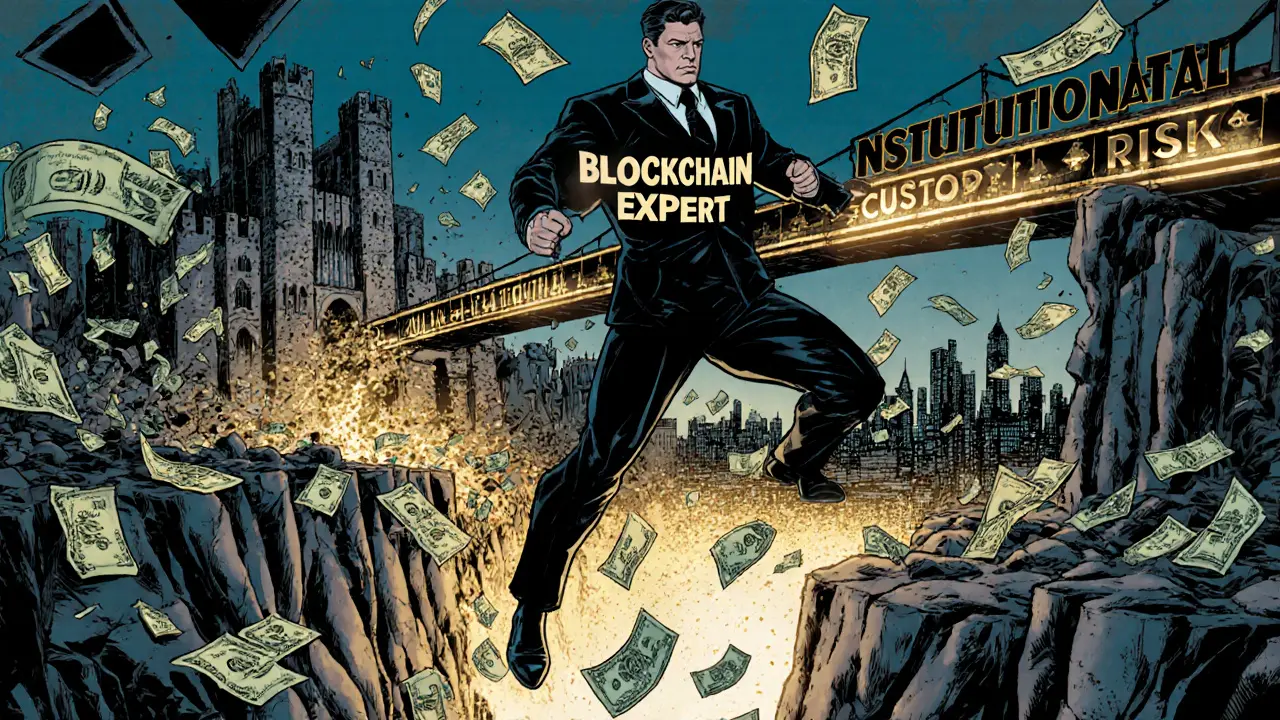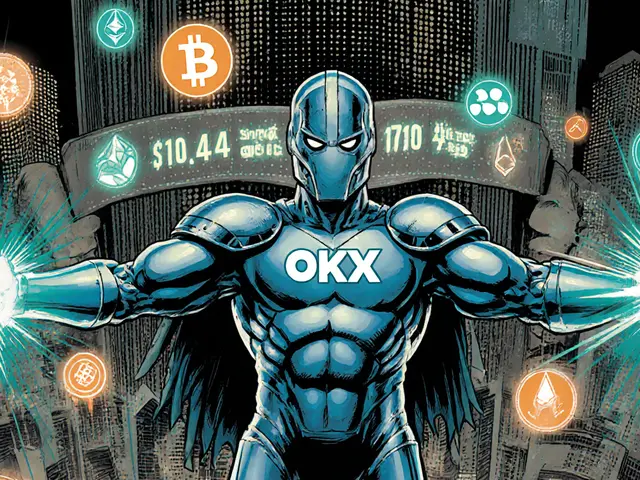
Institutional Blockchain Investment Barrier Assessment Tool
Assess Your Investment Barriers
This tool evaluates the seven key barriers preventing institutional investment in blockchain assets. Rate your current situation on a scale of 1-100 (1=low impact, 100=severe barrier).
Your Institutional Readiness Score
This score reflects your institution's readiness to invest in blockchain assets based on key barriers.
Why Institutions Are Still Sitting on the Sidelines of Blockchain
Over $130 trillion sits in institutional portfolios - pension funds, sovereign wealth funds, endowments - yet less than 3% of that is in blockchain-based assets. Why? It’s not because they don’t see the potential. It’s because the road to getting in is paved with obstacles that are harder to clear than the technology itself.
Regulatory Uncertainty Is the Biggest Wall
Institutional investors need rules they can bank on. But right now, the rules around digital assets change by the month. One country classifies Bitcoin as property. Another treats it as a commodity. A third says it’s a security. That kind of inconsistency makes compliance teams panic. A U.S.-based pension fund can’t legally allocate capital to a crypto asset if its legal team can’t guarantee it won’t trigger a regulatory violation next quarter.
Even the shift from mutual funds to ETFs has created confusion. While ETFs like Bitcoin spot funds are now approved in the U.S., they’re still blocked in the EU and Asia. Institutions that manage global portfolios can’t just pick and choose. They need harmonized frameworks - and they don’t exist yet. That’s not a technical problem. It’s a legal one. And until regulators align, institutions will keep their capital in government bonds instead of blockchain tokens.
Private Market Complexity Is a Minefield
Many institutions want exposure to blockchain through private markets - venture capital funds investing in Web3 startups, tokenized real estate platforms, private blockchain infrastructure providers. But here’s the catch: 66% of institutional investors plan to increase private asset allocations over the next five years, and nearly 90% already hold private equity and private credit. Yet, 40% of them admit they’re struggling to manage the growing number of managers and asset types.
It’s not just about finding deals. It’s about understanding them. A fund investing in energy infrastructure credit backed by blockchain smart contracts? That’s not your grandfather’s private equity. It requires deep expertise in both energy markets and decentralized ledger tech. Most institutions don’t have that skill set in-house. Hiring it is expensive. Training it takes years. And the talent pool is tiny.

Technology Infrastructure Isn’t Ready
Institutional investors don’t use Coinbase. They use Bloomberg terminals, BlackRock’s Aladdin, and custom risk platforms built over decades. These systems weren’t designed to track tokenized assets, verify on-chain ownership, or calculate smart contract exposure. Integrating blockchain data into legacy systems requires massive IT investment - and no CFO wants to spend millions on a system that might become obsolete in two years.
And then there’s cybersecurity. In 2025, 78% of institutional investors ranked cybersecurity as their top operational risk. A single breach in a blockchain custody solution could wipe out billions. That’s not a hypothetical. In 2024, a major European pension fund lost $220 million in a compromised multi-sig wallet setup. The incident didn’t happen because of poor crypto knowledge - it happened because the custody provider’s audit trail was incomplete. Institutions don’t fear the tech. They fear the gaps in the security stack around it.
Liquidity and Exit Risks Are Real
When you invest in a public stock, you can sell it in seconds. When you invest in a blockchain startup’s token, you might be locked in for five years. Even in secondary markets, liquidity is thin. McKinsey’s 2025 report showed private market fundraising hit its lowest level since 2016. That means fewer deals, and fewer chances to get out.
Institutional investors need to rebalance. They need to move money from underperforming assets to better ones. But if you’re stuck in a private blockchain fund with no secondary market, you can’t adjust your portfolio when markets shift. That’s a dealbreaker for funds that must meet quarterly liability targets - like pension plans paying out retirees.
Costs Are Rising, Value Is Fading
Active management fees for traditional assets are collapsing. Passive ETFs now dominate. That pressure is spreading to blockchain. But blockchain asset management isn’t standardized. There’s no S&P 500 for crypto. No widely accepted benchmark. So when an institution hires a manager to run a blockchain portfolio, they’re paying for research, due diligence, and custody - but they’re not getting the same level of transparency or service as they would with a traditional equity fund.
Smaller institutions are hit hardest. They can’t afford the $500,000 annual fee for a dedicated blockchain team. And they don’t get the same access to top-tier funds or early-stage deals. The result? Only the biggest players - BlackRock, State Street, Norway’s sovereign fund - are making meaningful moves. Everyone else is watching from the sidelines.

Geopolitics Is Making Cross-Border Investing Risky
Blockchain is global. But governments aren’t. In 2025, 34% of institutional investors named U.S.-China tensions as their top geopolitical risk. That means if you’re a European fund trying to invest in a blockchain project based in Singapore but funded by Chinese VCs, you’re now navigating export controls, sanctions risk, and data localization laws.
Even something as simple as using a U.S.-based blockchain analytics tool could trigger compliance issues in the EU under the Digital Operational Resilience Act (DORA). Institutions are being forced to build separate investment teams for different regions - a costly and inefficient workaround. The dream of a borderless digital asset market? It’s still just a dream.
People, Not Technology, Are the Bottleneck
Every barrier we’ve talked about - regulation, tech, liquidity, cost - comes back to one thing: people. Institutions don’t lack capital. They lack people who understand both finance and blockchain deeply enough to make decisions under uncertainty.
There are maybe 2,000 professionals worldwide who can build a blockchain portfolio strategy, assess smart contract risk, navigate SEC filings, and explain it all to a board of trustees. The demand? Over 15,000. That gap isn’t closing fast. Universities aren’t producing enough graduates with dual expertise. And the ones who do have it? They’re being poached by hedge funds and crypto firms paying 3x the salary.
It’s Not a Matter of If - But When
These barriers aren’t permanent. They’re transitional. The same thing happened with ETFs in the 1990s. With derivatives in the 2000s. With algorithmic trading in the 2010s. Institutions didn’t reject them. They adapted - slowly, painfully, and only after the risks were understood and mitigated.
Blockchain is no different. The institutions that will win are the ones building internal expertise now. The ones partnering with OCIO providers to manage transition risks. The ones investing in custody infrastructure before it becomes mandatory. The ones hiring blockchain-savvy risk officers before the competition does.
The money is coming. But only to those who are ready to climb the walls - not wait for them to disappear.
Why don’t pension funds invest more in blockchain?
Pension funds are bound by strict fiduciary rules that require safety, liquidity, and regulatory clarity. Blockchain assets still lack consistent global regulation, have volatile liquidity, and carry unproven long-term risk profiles. Until these issues are resolved, most pension funds can’t legally justify large allocations - even if the returns look attractive.
Are there any institutional investors already in blockchain?
Yes. BlackRock, Fidelity, and State Street have launched crypto ETFs or custody services. Norway’s sovereign wealth fund has quietly invested in blockchain infrastructure startups. But these are exceptions. Most institutions are still testing the waters with small allocations - under 1% of total assets - and only through regulated vehicles like ETFs or licensed custodians.
What’s the biggest operational barrier to blockchain investment?
The biggest operational barrier is integrating blockchain data into legacy systems. Most institutions use platforms built for traditional assets - stocks, bonds, real estate. These systems can’t track on-chain transactions, verify token ownership, or calculate exposure to decentralized protocols. Upgrading them requires millions in IT spending and years of testing - time most institutions don’t have.
Why is liquidity a problem for institutional crypto investments?
Most blockchain assets, especially in private markets, have no secondary market. If an institution needs to sell quickly - say, to cover a pension payout - they can’t. Even public crypto markets can freeze during volatility. Institutions need the ability to rebalance portfolios on demand. Without reliable liquidity, blockchain assets are too risky for large-scale allocation.
Will regulation ever catch up to make institutional investment easier?
Yes - but slowly. The U.S. has started approving crypto ETFs, and the EU’s MiCA regulation is setting clearer rules. But global alignment is still years away. Institutions need consistent rules across all major jurisdictions. Until then, they’ll keep treating blockchain as a niche, experimental asset class - not a core holding.
How do institutions assess risk in blockchain investments?
They use a mix of traditional risk models and new blockchain-specific tools. This includes on-chain analytics (like Chainalysis or Nansen), smart contract audits from firms like CertiK, custody security ratings from third parties, and stress tests for volatility and regulatory shock. But most institutions still lack the internal expertise to interpret the data - so they outsource it, adding cost and complexity.






There are 8 Comments
garrett goggin
Bill Henry
Jess Zafarris
jesani amit
Peter Rossiter
Mike Gransky
Ella Davies
Henry Lu
Write a comment
Your email address will not be published. Required fields are marked *